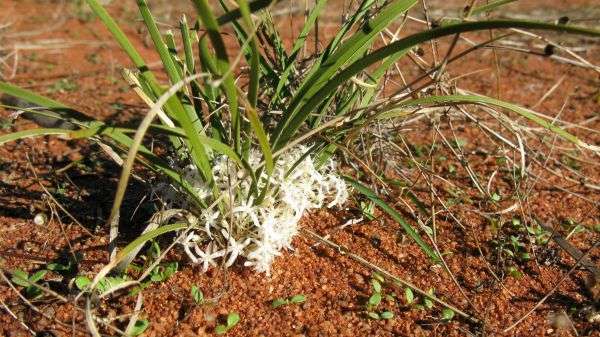Blitz survey uncovers Mid West mat rush

The recent discovery of the plant species Lomandra marginata (commonly known as mat rush), began with a casual conversation during a Bush Blitz survey.
Western Australian Herbarium researcher Terry Macfarlane was chatting to a colleague who mentioned an unusual patch of spinifex (Poaceae) on a new Mid West conservation reserve.
The spinifex in question grew on the borders of Karara and Lochada former station leases, with nothing similar for miles.
So Dr Macfarlane journeyed to the area to examine the spinifex patch and while there stumbled upon an unusual little plant that looked like it could be one of two genusera—Chamaexeros or Lomandra.
Though it had leaf edges more typical of Chamaexeros, Dr Macfarlane suspected it was more likely to be Lomandra because, unlike Chamaexeros, it appeared to have separate male and female plants.
Although the species wasn't flowering, Dr Macfarlane collected a specimen and took it back to the lab.
He studied the species under the microscope, consulted flora keys and delved into the herbarium's collection of scientific specimens to compare it with existing species.
He soon realised this species of Lomandra was undescribed but he needed to examine its flowers to provide a full description and name the species.
Several subsequent trips failed to unearth the species in flower, though Dr Macfarlane did find other populations of the same plant growing on different soil types.
Eventually, he returned after autumn rains and found the species in flower.
"It had these really attractive big bunches of dense, snow-white flowers," Dr Macfarlane says.
Further investigations revealed it had been collected before—but filed with unidentified Lomandra specimens—and not formally described and named.
Consequent research revealed the plant is in fact widespread, stretching from Kalbarri to Corrigin and inland to Southern Cross.
Dr Macfarlane says such a discovery was possible thanks to generations of botanists collecting specimens for examination.
"Ecologists, unable to find flowers, collected this species even when it wasn't flowering, whereas flowering specimens are normally preferred," he says.
"Fortunately this Lomandra can be recognised without flowers so those apparently inferior specimens turned out to provide valuable location records.
"This is a good example of how the full usefulness of biological survey work often isn't revealed until much later."
Provided by Science Network WA




















